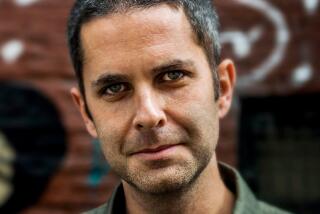DISCOVERIES
- Share via
Three Bedrooms
in Manhattan
A Novel
Georges Simenon, translated
from the French by Marc Romano
and Lawrence G. Blochman
New York Review Books:
158 pp., $12.95 paper
Perhaps you are a fan of Georges Simenon already, of his Inspector Maigret novels, the most popular of his 400-plus books. Or perhaps you have long been intimidated by the fact that he wrote his books in nine or 10 days, three of them spent revising. Or maybe you heard that he slept, he claimed, with more than 10,000 women (“most of them prostitutes”). But have you read the novels the author labeled dur?
“Three Bedrooms in Manhattan,” first published in France in 1946, when Simenon was 43, must have been dur, or hard, for the author himself. It was, Joyce Carol Oates writes in her introduction, one of his most autobiographical novels. Francois Combe, once a famous actor, finds himself hiding in New York after a scandal involving his wife tarnishes his career in France. When Simenon wrote the novel, he had been accused of “wartime collaboration.” He had also just met, in Manhattan, a woman 17 years his junior whom he would soon divorce his wife to marry. “Three Bedrooms in Manhattan” is about how we resist love, how we get dragged into it, spat out, dragged back in against our will.
In a diner one night (“on the corner, its high windows lit violently, aggressively, with boastful vulgarity, was a sort of long glass cage...”), Combe meets Kay, a woman almost as lonely as himself. Both have thrown themselves into the New York night, desperate for human contact. They walk and walk and drink and walk and finally make love in a “seedy” hotel room. The next room is Combe’s own shabby hideaway, which is of course transformed by love. And finally, the bedroom that Kay has shared with a departed roommate. (“The walls were painted a soft white, the cretonne spreads on the twin beds were imitation toile de Jouy.... “)
Blinking neon blankets the story in an atmosphere of general decay -- in life and trust and the merest possibility of love. “He was a man who had cut all threads,” Simenon describes Combe, “a man approaching fifty, without ties to anything -- not to family, profession, country, himself, and definitely not to a home. His only connection was to a complete stranger, a woman sleeping in his room in a seedy hotel.” Simenon takes whatever slender threads he can find in his characters that hold them to life. He shows how relentlessly the mind tries to sabotage the heart.
*
Bench Press
Sven Lindqvist, translated from the Swedish by Sarah Death
Granta: 122 pp., $12.95 paper
Sven LINDQVIST, a self-professed intellectual, met a skinhead in a sauna one day -- the scary kind, big, threatening, muscular. This skinhead became his Virgil into the world of heavy lifting. The author found himself in grimy gyms with some of the nicest, most polite athletes he had ever met. And he found childhood memories returning in flashes as he lifted, from a cheese sandwich to his aged grandmother. “I’ve never been interested in sport,” he writes. “I actively detest all ball sports and taking exercise bores me. Yet I liked it at the gym.” “Short, fat and awkward” is how Lindqvist describes himself as a child. In conversations with “Virgil” (the name Lindqvist gives his skinhead), the author comes to believe in nothing less than the power of transformation, of change. Wanting to be strong, healthy, even beautiful and dangerous -- these were not impulses Lindqvist had ever explored. “Art,” he demurs, “is often born out of early physical humiliation.” He comes to love the exertion and the single-mindedness, which “creates an inward stillness that is liberating.”
The essay is illustrated with charming woodcuts from Leonardo da Vinci’s notebooks and from Mercurialis’ training manual “De arte gymnastica” (1569), and there are line drawings of early weights and machines, including an “exercise doll” for children (1915). Lindqvist’s writing, as it lurches toward revelation (musing on fontanelles, obsessions with the metaphors of the Sahara Desert), reminds this reader of Annie Ernaux, another essayist who leaves us a little closer down the road to Will, and running hard from Fate.
More to Read
Sign up for our Book Club newsletter
Get the latest news, events and more from the Los Angeles Times Book Club, and help us get L.A. reading and talking.
You may occasionally receive promotional content from the Los Angeles Times.









